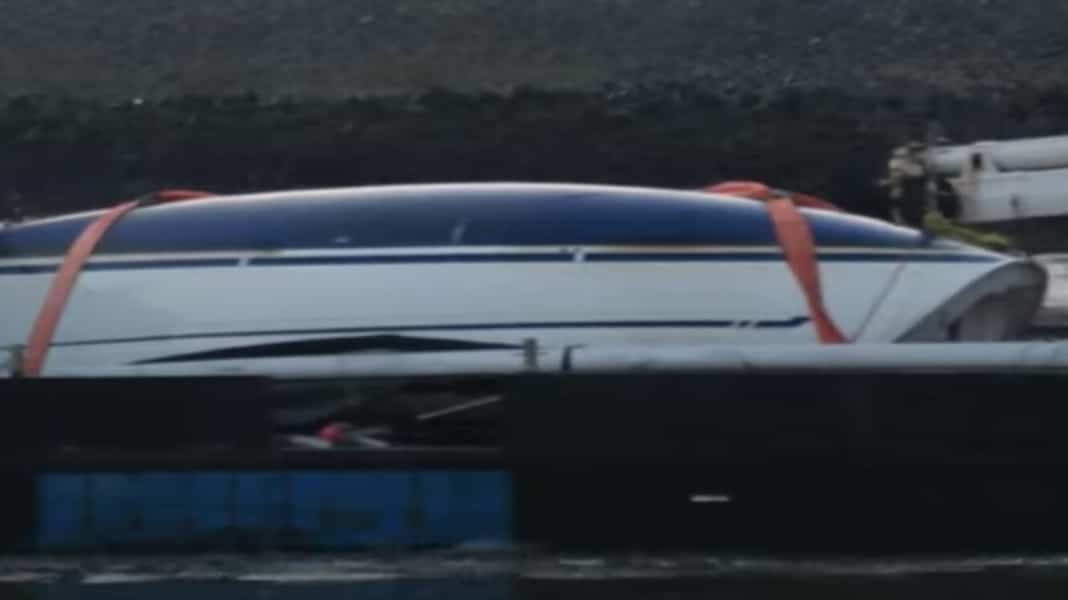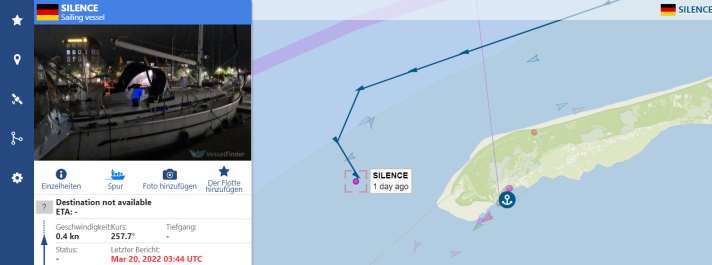
Once again, the sea gates rightly feared by many sailors have wreaked havoc on a crew or their ship. At around 5.15 a.m. on Sunday morning, the Dutch maritime rescue organisation KNMR received an alarm from a GMDSS distress signal. A Bavaria 40 coming from Emden had run aground on a sandbank west of Terschelling. Grounding and swell caused the keel to break and the boat capsized shortly afterwards. The crew managed to save themselves in a life raft.

Two lifeboats from the stations of Vlieland and Terschelling and a SAR helicopter searched for the crew of the sunken yacht. The rescuers from Terschelling were the first to reach the scene of the accident, according to Dutch media reports. The helicopter mission was cancelled and the crew was brought to the West Frisian island by the KNRM. One crew member required medical treatment for hypothermia.
The accident occurred shortly after low tide about five miles north-west of Terschelling on the "Gronden van Stortemelk", an area with numerous shallows. At the time, there was a fresh wind of 4 to 5 Beaufort from the east with stormy gusts. According to the Dutch media, the yacht had only just been purchased by the crew. The sailors had wanted to test the boat and sail between the islands to Harlingen.
The yacht has since been salvaged and brought to Harlingen harbour, as can be seen in the video here
The accident in this sea area is not an isolated incident. The straits between the West Frisian Islands and the East Frisian Islands in particular have often become a trap for ships in the past. In wind-against-current situations, strong winds and ebb currents, many of the channels simply become impassable. In some cases, violent bottom seas form there, in the troughs of which ships can suddenly run aground, even though the charts suggest that there is plenty of water under the keel at the time of the tide.
Area expert and YACHT author Holger Peterson has experienced it himself with his boat. In a report that appeared in YACHT 20/2012, he wrote:
27 September 2008: We enter the Harle between Wangerooge and Spiekeroog from the sea. Good visibility, north-westerly wind around four. According to the chart, it is still two metres deep on the bar in front of the islands at low tide. We are there three hours before low water, so we can expect a depth of 3.50 metres. The long keel of the "Paloma" is 1.20 metres deep.
We know from experience that the depth on the barre at buoy H4 decreases from six to around two metres below the keel within 50 metres. But this time it's different, and it happens very quickly: 2 ... 1 ... 0 ,2 ... 0! With a rumble, the nine-tonne "Paloma" touches down in the short sea. Every wave sends the eleven-metre steel yacht crashing back onto the hard sand. The rigging trembles. Crossing threatens. It rumbles violently under the keel several times - then we are over it. A GRP yacht with a short keel would not have survived this.
Okay, rookie mistake, sailing through here when the water was running out. But that has always worked with the tide - why not today? A look back: white breaking waves on the west side of the buoys, where it should be deep. Smooth and therefore deep water to the east of the buoys, where it should be shallow. You couldn't see that with the waves.
We want clarity and to turn round. In fact: on the "wrong side" of the buoy line, the shallowest part is still 3.5 metres deep! A depth reduction of around three metres within a buoyed fairway - the hourly radio station should be reporting that!
"Follow-up check" two weeks later at the same tide level. That night there was a fresh north-westerly wind, so to be on the safe side I passed the buoys on the "wrong" side. Three metres of water, everything was fine. But heavy seas in the fairway. Mercy on the skipper who trusts the buoys here!
Petersen's basic rules against grounding:
Sea races on the East Frisian coast are taboo for yachts from wind force five from northerly directions. The same applies to the North Frisian coast in westerly winds. Also take old seas into account when assessing the situation! Only approach the Gatten when the tide is halfway out and the water is rising. Take care in wind-against-current situations. The mainsail should be hoisted completely, especially on rough courses. This is because, despite all caution, there is still a risk of the mainsail jibing. Keep the headsail up and the engine running, as seas rolling in from astern can exceed the sailing speed, in which case the flow at the rudder breaks off. Slowly steer into the buoy line from the approach, pay constant attention to the plumb line and concentrate on steering in the channel!

